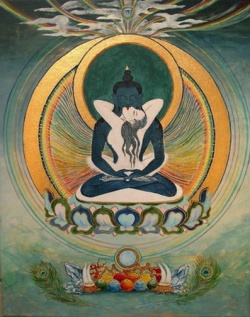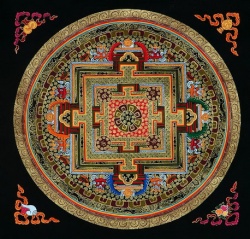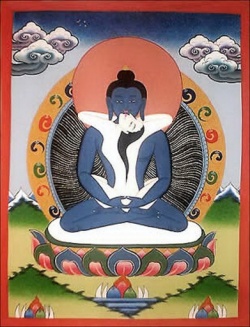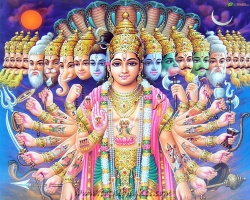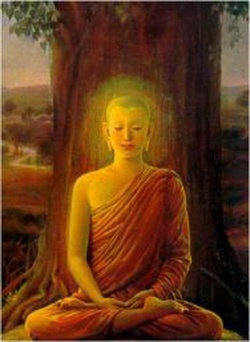Adi-Buddha vs Gautama Buddha
In the puranas Buddha is mentioned as an avatara of Vishnu.
Usually Siddhartha Gautama Buddha a.k.a. Sakya Simha Muni is known as "the buddha."
It seems that he wasn't the first Buddha (this is also believed in Buddhism) and that the Buddha Avatara of Vishnu might have been the adi-buddha or the first Buddha known as Sugata.
Ignoring the hare krishna propaganda against mayavada, this distinction of Buddhas is a very good point and very relevant to Hinduism.
Were the later teachings of the heart sutra and of nagarjuna radically different from the teachings of Sakya Muni Buddha?
How much doctrinal consistency is there from the Adi Buddha up towards the Buddhist sects known today.
The Buddhist are less obsessed with authority or pramanas than the Hindus, they value internal experience more. This might have influenced the doctrinal consistency.
Were the Buddhas before Sakya Muni all teaching Hindu doctrine? Sakya Muni was practicing Hindu yoga until his awakening, he must have come from a line of Hindu Munis that go back towards Sugata Muni, the avatara of Vishnu.
In the Buddhist writing Amarakosha, written by the famous Amara Simha, who lived about 150 years before Shankaracarya, the following verses about Buddha are found:
sarvajJaH sugato buddho dharmarAjas tathAgataH
samanta bhadro bhagavAn mArajil lokjij jinaH
SaDabhijJo dazabalo’ dvayavAdI vinAyakaH
mnunindrA zrIghananH zAstA muniH
All knowing, transcendental Buddha, king of righteousness,
He who has come, beneficent, all encompassing Lord, conqueror of the God of Love Mara, conqueror of worlds,
He who controls his senses , protector of the six enemies, possessor of the ten powers, speaker of monism, foremost leader, lord of ascetics, embodiment of splendor and teacher of the ascetics.
The above verse contains eighteen names of Vishnu Avatara Buddha including the name Sugato, and the verse below contains the seven aliases of Sakya Simha Buddha without any mention of the name Sugato.
zAkyamunis tu yaH sa zAkyasiMhaH sarvArthasiddha zauddhodaniz ca saH gautamaz cArkabandhuz ca mAyAdevI sutaz ca saH
Teacher of the Sakyas, lion of the Sakyas , accomplisher of all goals, son of Suddhodana, of Gautama’s line, friend of the entrapped ones, the son of Maya-devi.
In his commentary to Amarakosha by the learned Raghunatha Cakravarti, he made a clear distinction between the verses.
To the eighteen names of Vishnu avatar, Buddha, he writes the words “astadaz Buddha”, and on his commentary for the seven aleases of Sakya Simha he writes:
“ ete sapta Zakya banhzabatirneh Buddha muni bishete”, meaning “
the next seven names starting form Sakya-muni are aliases of Buddha-muni, who was born into the Sakya dynasty.”
The learned readers can refer to the Amaraksha published by the respected Mr. H.T. Colebrooke in 1807. On pages 2 and 3 of this book the name Buddha has been explained.
The “Marginal Note” for the first 18 names, states they are names of (the son of) Ajina or Buddha and the “Marginal Note” for the later seven names states they are aliases of Sakhya Simha Buddha.
A further footnote is added to clarify the second Buddha, the Buddha of the seven names, as “the founder of the religion named after him.”
Mr. Colebroke lists in his preface the names of the many commentaries he used as references.
Besides Raghunatha Cakravari’s commentaries he took reference from twenty-five others.
Sakhya Simha or Siddharta Buddha, received the name Gautama from his spiritual master Gautama Muni, who belonged to the Kapila dynasty.
This is confirmed in the ancient Buddhist treatise “Sundarananda Carita”:
“guru gotrAd ataH kautsAste bhavanti sma gautamAH”
– meaning “O” Kautsa, because his teacher was Gautama, they became known form his family line”.
Besides the Amarakosha, highly favored by Sankar-acarya, there are other famous Buddhist texts like Prajna-Paramita Sutra, AStashastrika PrajJA-PAramitA Sutra, Sata-sahastrika PrajJA-paramaitA Sutra, Lalita Vistara, whose proper scrutiny reveals the existence of three categories of Buddha, namely:
- human Buddhas: like Gautama, who attain the enlightenment and become a Buddha
- bodhisattava buddhas: like Samanta Bhadraka, who were born enlightened
- Adi (original) Buddha - bhagavan
The Amarakosha stated that Lord Buddha, Vishnu’s avatara, is also known as Samanta Bhadra, whereas Gautama Buddha is a human being.
In Lalita Vistara, Ch. 21 page 17, it is described how Gautama Buddha meditated on the same spot as the predecessor Buddha:
ca dharaNImuNde pUrvabuddhAsanasthaH samartha dhanur gRhItvA zUnya nairAtmavANaiH klezaripuM nihatvA dRStijAlaN ca bhitvA ziva virajamzokAM prApsyate bodhim agryAM
The one seated on the hallowed earth on the previous Buddha’s birthplace, is on the path of voidism and renunciation .
With his weapon, the powerful bow, he vanquishes the enemies of distress and illusion.
Thus with wisdom he will attain the auspicious state of grieflessness and worldly detachment.
The ancient and original name of this place was Kikata, but after Gautma attained enlightenment here it came to be known as “Buddha (Bodhi) Gaya”.
Even to the present day, the rituals of worship to the deity of Buddha at Bodhi Gaya are conducted by a sannyasi of the Grii order belonging to the Sankar-acarya sect.
It is commonly accepted amongst these monks that Buddha-Gaya (Vishnu avatar) was a predecessor of Bautama Buddha, who came later to the original Buddha’s birthplace to practice meditation.
Lanka-avatara Sutra is a famous and authoritative Buddhist text.
From the description of Buddha, which is found in this book it may be firmly concluded that he is not the more recent Sakya Simha or Gautama Buddha.
In the beginning of this book we find Ravana, King of Lanka, praying first to the original Vishnu avatar, Buddha and then to the successive future Buddha.
laNkAvatAra sUtraM vai pUrva Buddha anuvarNitaM smarAmi pUrvakaiH buddhair jina-putra puraskRtaiH sUtram etan nigadyante bhagavAn api bhASatAM bhaviSyatyanAgate kAle buddhA Buddha-sutAs ca ye
Ravana, the king of Lanka, at first recited in the Totaka metre then sang the following –
“I invoke in my memory the aphorisms known as “Lanaka-avatara-sutra, compiled and propagated by the previous Buddha, the son of Jina, and presented in this book.
Lord Buddha and his sons, who will appear in the future, as well as Bhagavan (Ravana was a worshiper of Siva), will continue to instruct all form this book.”
Here Ravana speaks of Bhagavan Buddha, the son of Jina, a Vishnu avatara.
The fact that Buddha, the son of Jina is a Vishnu avatara is confirmed in Bhagavata purana 1.3.24
tataH kalau sampravRtte sammohAya sura-dviSAm buddho nAmnAJjana-sutaH kIkaTeSu bhaviSyati
Then in the beginning of Kali-yuga, the Lord will appear as Buddha, the son of Ajjana, in the province of Gaya, just for the purpose of deluding those who are envious of the faithful.
Sridhara Svami writes in his authoritative commentary to this verse:
Buddha avartAramAha tata iti aJjanasya sutaH ajina suta it pAThe ajino’pi sa eva kIkaTeSu madhe gayA-pradeze
The words “tataH kalau…” describe Vishnu’s avatara Buddha as the son of Ajjana. Ajina in the word “ajina sutaH” actually means “AJjana” Kikata is the name of the district of Gaya.
The monists, either by mistake or some other reason, regard Sridhara Svami as belonging to their sect and persuasion, although only Vaishnavas write commentaries to Bhagavata purana.
Lord Buddha also finds repeated mention in the revealed scripture, like Vishnu Purana, Vayu Purana and Skanda Purana.
The Buddha mentioned in Devi Bhagavat, a more recent text and in Sakti Pramoda refers to Sakya Simha not to Vishnu Avatara.
Sakya Simha was born in Kapilavastu, and Lord Buddha appeared in Kikata, which is now famous as Bodhi-Gaya.
Sakya Simha or Gautama Buddha’s father was known as Suddhodana, while his mother was Maya-devi, this is all accepted historical fact.
He cannot be mistaken with Lord Buddha, which is described as the son of Ajjana in the vedic literature , and in the Buddhist literature as the son of Jina
In Hindu scriptures
The Buddha is described in important Hindu scriptures, including almost all the Puranas.
However, not all of them refer to the same person: some of them refer to other persons, and some occurrences of "buddha" simply mean "a person possessing buddhi".
Most of them, however, refer to the founder of Buddhism.
They portray him with two roles: preaching false views in order to delude demons or others, and criticizing animal sacrifice as prescribed in the Vedas.
A partial list of Puranas mentioning the Buddha is as follows:
Harivamsha[] (1.41)
Vishnu Purana (3.18)
Bhagavata purana (1.3.24, 2.7.37, 11.4.23) [12]
Garuda Purana (1.1, 2.30.37, 3.15.26)[13]
Agni Purana (16)
Narada Purana (2.72)
Linga Purana (2.71)
Padma Purana (3.252) etc. (Dhere Ramchandra Chintaman) [14]
In the Puranic texts, he is mentioned as one of the ten Avataras of Vishnu, usually as the ninth one.
Another important scriptures that mentions him as an Avatar is Rishi Parashara's Brihat Parashara Hora Shastra (2:1-5/7).
He is often described as a yogi or yogācārya, and as a sannyāsi. His father is usually called Śuddhodhana, which is consistent with the Buddhist tradition, while in a few places the Buddha's father is named Añjana or Jina.
He is described as beautiful (devasundara-rūpa), of white or pale-red complexion, and wearing brown-red or red robes.
Only a few statements mention the worship of Buddha, e.g. the Varahapurana says states that one desirous of beauty should worship him.[16]
In some of the Puranas, he is described as having taken birth to "mislead the demons":
mohanārthaṃ dānavānāṃ bālarūpī pathi-sthitaḥ । putraṃ taṃ kalpayām āsa mūḍha-buddhir jinaḥ svayam ॥tataḥ saṃmohayām āsa jinādyān asurāṃśakān । bhagavān vāgbhir ugrābhir ahiṃsā-vācibhir hariḥ ॥
—attributed to Brahmanda Purana, quoted in Bhāgavatatātparya by Madhva, 1.3.28
Translation: To delude the demons, he (Lord Buddha) stood on the path in the form of a child.
The foolish Jina (a demon), imagined him to be his son.
Thus the lord Sri Hari [as avatara-buddha expertly deluded Jina and other demons by his strong words of non-violence.
In the Bhagavata purana Buddha is said to have taken birth to restore the devas to power:
tataḥ kalau sampravṛtte sammohāya sura-dviṣām ।buddho nāmnāñjana-sutaḥ kīkaṭeṣu bhaviṣyati ॥
—srimad-bhagavatam 1.3.24
Translation: Then, in the beginning of Kali-yuga, for the purpose of confusing the enemies of the devas, [he] will become the son of Anjana, Buddha by name, in the Kīkaṭas.
In many Puranas, the Buddha is described as an incarnation of Vishnu who incarnated in order to delude either demons or mankind away from the Vedic dharma.
The Bhavishyaurana contains the following:
At this time, reminded of the Kali Age, the god Vishnu became born as Gautama, the Shakyamuni, and taught the Buddhist dharma for ten years.
The times ascribed to one "Buddha" figure are contradictory and some put him in approximately 500 CE, with a lifetime of 64 years, describe him as having killed some persons, as following the Vedic religion, and having a father named Jina, which suggest that this particular figure might be a different person from Siddhārta Gautama.[20]
